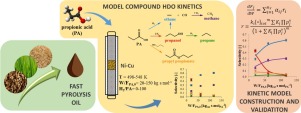Applied Catalysis B: Environment and Energy ( IF 20.2 ) Pub Date : 2018-03-20 , DOI: 10.1016/j.apcatb.2018.03.062 Daria Otyuskaya , Joris W. Thybaut , Vaios Alexiadis , Maria Alekseeva , Robbie Venderbosch , Vadim Yakovlev , Guy B. Marin

|
Propionic acid hydrotreatment was investigated as a model reaction for fast pyrolysis oil stabilization over a Ni-Cu/SiO2-ZrO2 catalyst. Intrinsic kinetics were acquired within a wide range of operating conditions resulting in an extended dataset of 37 experiments. Two major Ni-catalyzed conversion pathways, being hydrogenation to propanol and decarbonylation into ethane and carbon monoxide, were identified. Propanol, formed on the Ni sites after a series of hydrogenation steps, was found to also undergo decarbonylation at the investigated operating conditions. Additionally, the metal oxide support, catalyzed the esterification between propionic acid and propanol. The observation of only traces of decarboxylation and ketonization products indicated that these conversion pathways were not particularly pronounced in the investigated range of operating conditions. Due to the experimentally observed high methanation activity of Ni-Cu/SiO2-ZrO2, the hydrogenation route, which was favored at lower temperatures and higher total and partial hydrogen pressure was determined to be the preffered conversion pathway as compared to the decarbonylation route. The acquired experimental dataset was utilized for the construction of a comprehensive hydrodeoxigenation kinetic model based on elementary steps. The first step, which is a joint one in the decarbonylation and hydrogenation route, was found to be rate determining with activation energy of 118 kJ mol−1. The higher selectivity to propyl propionate compared to propane was ascribed to the higher affinity of propanol for the metal oxide support than for metal active sites.
中文翻译:

以丙酸为模型化合物的Ni-Cu催化剂上快速热解油稳定动力学
研究了丙酸加氢处理作为Ni-Cu / SiO 2 -ZrO 2上快速热解油稳定化的模型反应催化剂。在广泛的操作条件下获得了内在动力学,从而得到了37个实验的扩展数据集。确定了两个主要的镍催化的转化途径,即氢化为丙醇和脱羰基为乙烷和一氧化碳。在一系列氢化步骤后,在镍位点上形成的丙醇在所研究的操作条件下也发生脱羰作用。此外,金属氧化物载体催化了丙酸和丙醇之间的酯化反应。仅观察到痕量的脱羧和酮化产物表明,这些转化途径在所研究的操作条件范围内不是特别明显。由于实验观察到的Ni-Cu / SiO 2高甲烷化活性与脱羰途径相比,在较低的温度和较高的总氢和部分氢压力下有利的氢化途径-ZrO 2被确定为优选的转化途径。将获得的实验数据集用于基于基本步骤的综合加氢脱氧动力学模型的构建。发现第一步是脱羰和氢化途径中的联合步骤,是用118kJ mol -1的活化能确定速率的。与丙烷相比,对丙酸丙酯的更高选择性归因于丙醇对金属氧化物载体的亲和力高于对金属活性位点的亲和力。











































 京公网安备 11010802027423号
京公网安备 11010802027423号